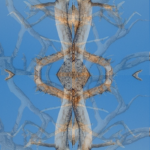In his Lectures on the Psychology of Yoga, Jung describes an interesting type of Buddhist meditation (which he finds in the Chakrasambhara Tantra). The goal of this meditation is awareness of one’s own psychology, and a separation of anything that’s going on there from the conscious personality (ego). The basic idea is to realize one’s psychological functions and then imagine them to be separate figures and visualize those figures.
This personification has been undertaken here for the senses. If that personification is successful […] I place my sensory functions as it were all around me. They become figures, devatâs, divine beings. My sight is autonomous; this one hears and that one sees and a third one tastes, etc.
C. G. Jung, Psychology of Yoga and Meditation, 97.
So in this example, the sensory functions (sight, hearing, taste, …) are observed and imagined to be autonomous beings, independent of the conscious personality:
the entire character of the psychic process is somehow objectified, it takes on a life of its own. With it, the activity is sort of distanced from consciousness (ibd., 96).
The effect is twofold. For one thing, the practitioner becomes imperturbable with respect to external events (which, according to Buddhism, is the correct attitude, since they are illusionary):
It achieves a habitual attitude whose aim is to stay utterly removed from immediate contact. This attains complete other-worldliness, an infinite peace arises. […] That process creates these images of the Buddha sitting in infinite peace in the turmoil of the world: it is all an illusion, none of it is present (ibd., 98).
And secondly, since those functions are no longer part of the ego personality, the latter gets reduced, emptied out (which is just as well, since according to Buddhism, it is illusionary, too):
The whole personality, all my functions, are paraded before me as autonomous figures. Through this I have become completely empty. One achieves that with this meditation, and that is also the purpose, that emptiness, shûnyatâ is created and one finally owns nothing any longer. […] one empties oneself of these functions. One no longer has them (ibd., 96).
(This change away from “having” a psychological episode is what I have generally called perspective reversal on this blog.)

1. We can find the same idea, or at least all of its ingredients, elsewhere in the Jungian sphere of ideas; we might formulate it as a withdrawing of projections from the ego.
Withdrawing projections, of course, is a central element in Jung’s views of personal development. Projections are problematic because they distort reality: both the external world and the inner, psychological world. To “withdraw” them means to realize that something which appears to belong to an external object is really part of one’s own subjectivity, and to re-integrate that part with one’s broader personality.
Now we have to extend our notion of projection somewhat. Following Stein, we could say that there is another form of projection where the screen onto which we project is not an external object (typically: another person), but rather one’s own self-image as a conscious person (one’s ego personality). If there is a kind of projection onto the ego, then there can be a corresponding withdrawal of such projections, too.
But what exactly is the projection we’re talking about here?
Any projection is a process in which a projection-making factor (an unconscious complex) produces a psychological content (a thought, an emotion, a memory image, a fantasy, … — or just a mixture of all those) of which the subject then becomes conscious as if it appeared in an object. The crucial thing about projection is this latter element: it is a certain kind of self-deception. The subject believes they observe something about another person, whereas in reality what they observe are their own unconscious thoughts, emotions, etc.
Now, in the case of projections onto the ego, we still have a projection-making factor that produces a psychological content. Again the subject becomes aware of that content — but this time as if it had produced that content (actively and deliberately). The subject does two things: first, it becomes conscious of the psychological content, and secondly, it believes it just generated that content by itself. (Hence the idea of “I had a perception”, “I had a thought”, “I had a dream”, and so on.) In projections onto an other person, the subject falsely perceives the content to be an objective attribute of that other person; in projections onto the ego the subject falsely perceives the content to be its own product.
If we apply this to the Buddhist meditation Jung explicates in his lecture, with the sensory functions as example, we end up with the following interpretation. The ordinary process of sense perception, e.g. seeing something, involves actually two things: first, a perceptual content (the image that is seen) is produced in the subject, and secondly, the ego personality becomes aware of that content (the seen image) in the mode of something it has produced itself. In reality, the perception happens unconsciously, and the wrong belief of the ego to be the producer of it is a projection. To withdraw this projection, the subject would have to become aware of the unconscious (automatic) nature of the process of perception. And that is what the meditation achieves: the visualization teaches the subject (not just intellectually, but as integrated experience) that the arising percepts are not products of the ego (where they were projected, earlier), but of something else (independent, automatic perceptual subsystems of the organism, say) which is now visualized in the form of separated figures.
(Note here that the figures, i.e. the devatâs which personify the senses, are not projections. They are imagined representations or metaphors used to withdraw the projections. The projection is the process that results in the false belief of the ego to be the origin of the percepts.)



